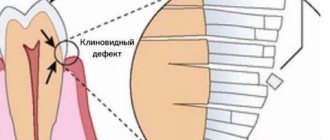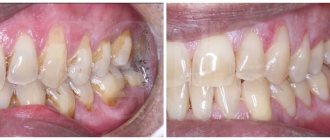Deep caries is the last stage of dental caries and is considered an advanced form of the disease. It is more difficult to treat, but even at this stage you can do without removal. Modern materials and technologies make it possible to restore a tooth while maintaining its functionality. We will tell you what methods of treating deep caries are available.
In this article
- First stage of caries
- Second stage of caries
- Middle stage of caries
- Stage four: deep caries
- How to treat deep caries
- Possible complications in the treatment of deep caries
Caries is a complex and progressive pathological process that destroys hard tooth tissue and develops as a result of exposure to internal and external factors. The direct causative agent of the disease is cariogenic microorganisms. They secrete harmful acids, which first corrode the inorganic component of the enamel, then its organic part and penetrate the dentin, forming a carious cavity. If caries is not treated, inflammatory complications arise from the pulp and periodontium.
The presence of bacteria alone is not enough for the appearance of a carious lesion, since they are present in the mouth of every person and are considered opportunistic. Under certain conditions, for example, poor hygiene, abuse of sweets or weak immunity, microbes actively multiply and wash minerals out of the enamel. This process is called demineralization. Gradually, the carious cavity spreads and covers almost all tooth tissues.
Caries can be cured at any stage, but the later the patient goes to the dentist, the more difficult the treatment process. First, we will describe the stages of development of the carious process, after which we will talk about methods of treating deep caries.
First stage of caries
The initial stage of caries is the white spot stage; it is an area of enamel demineralization. The internal tissues of the tooth are still protected from bacteria. The person does not feel discomfort and does not even know about the development of pathology. It can only be identified at this stage during a preventive examination. However, not all people visit the dentist every six months, so caries is rarely detected at the first stage.
The disease progresses, the enamel softens and becomes loose. The pathological process can be stopped with the help of special fluoride-containing drugs. This treatment of caries is called remineralization of enamel; it is saturated with minerals and strengthened. The application of protective compounds that restore the structure of the enamel surface is carried out in a doctor’s office.
For home use, he prescribes toothpastes, gels and rinses that have antibacterial properties and contain calcium, fluorine, magnesium and other minerals. Examples of such products are ROCS Active Calcium toothpaste, DRC ROCS (ROCS) Medical Minerals gel and Vivax Remineralization balm.
Diagnostic nuances
Diagnosis of root caries is carried out in exactly the same way as in the case of other varieties of this disease. However, standard methods do not always detect the disease. For example, a simple visual inspection rarely gives a good result. But classical sensing with a mirror is quite effective here. And, of course, in this situation, x-rays are the most reliable means.
Sometimes the disease can be hidden by tartar; do not forget about regular preventative cleaning of the oral cavity at the dentist.
Independent preliminary diagnosis is also possible. Arm yourself with a toothpick and stand in front of the mirror. You need to carefully run the wooden tip along the tooth near the gum. If it becomes painful, if you feel unevenness, and if the surface seems uneven, it’s time to visit the dentist.
Second stage of caries
The second stage of carious lesion is called superficial. The carious process continues to destroy enamel, but has not yet transferred to hard tissues. The white spot darkens, becomes brown or yellow. It can be seen with the naked eye, especially if it is on the outside of the front tooth. The first subjective signs of the disease also appear: discomfort is felt after eating sweet foods.
Cariogenic microbes live off carbohydrates. The more sweets a person eats, the more bacteria multiply in the mouth. Because of this, caries continues to progress. However, even at this stage, people often ignore the symptoms of the disease, explaining discomfort while eating by increased sensitivity of the teeth, which is not associated with pathologies. Immediately after eliminating the irritant, the unpleasant sensations disappear.
Superficial caries can still be cured with therapeutic methods, that is, by remineralizing the enamel. If treatment is not started and the pathology develops to the third stage, a filling must be placed.
Disease prevention
Properly treated root caries has a favorable prognosis. But sometimes a secondary carious lesion develops around the filled area. This may be due to the patient’s health status, as well as his failure to comply with oral hygiene rules.
To prevent caries damage to filled and intact (healthy) teeth, it is necessary:
- Treat gum recession promptly.
- Regularly undergo professional hygiene procedures at the dentist.
- If you find exposed root surfaces, immediately make an appointment with a specialist.
- For daily brushing of teeth, use toothpastes recommended by your dentist.
- Use dental floss, brushes and irrigators for high-quality cleaning of interdental spaces.
- Rinse your mouth with special products or warm water after each meal.
- Increase the amount of fresh fruits and vegetables, dairy products in the diet, and reduce the proportion of sweets and flour products in it.
- Eliminate smoking and reduce alcohol consumption as much as possible.
Your doctor will tell you about additional preventive measures after examining and assessing the condition of your oral cavity.
Middle stage of caries
The third, or middle stage of the carious process is accompanied by damage to the hard tissues of the tooth, into which cariogenic microbes penetrate. A brown hole forms in which bacteria multiply. A tooth affected by caries reacts painfully not only to sweet foods, but also to sour, cold and hot foods. Pain can even occur due to cold air entering the oral cavity. Painful sensations are usually short-term and pass quickly, once the irritant is eliminated. Another symptom that appears is bad breath.
It is useless to treat teeth at the third stage using compounds with minerals. It is necessary to put a filling. We list the main stages of treatment for third-degree caries:
- anesthetizing the tooth with an injection;
- cleaning the carious cavity from dead tissue;
- installation of a seal;
- grinding and polishing.
At the third stage, the carious process covers only hard tissue and does not penetrate the pulp, so some patients undergo the procedure without anesthesia. The tooth is treated in one visit to the dental office. Treatment of deep caries can be more difficult, due to the large scale of tissue damage.
Tooth root caries and its etiology on video
Risk group
The risk group for developing tooth root caries includes people who have periodontal disease. Deep periodontal pockets filled with dental plaque contribute to the penetration of the carious process into the pulp.
Elderly people are also at risk. They often experience gum recession, where the roots of the teeth are exposed. Against the background of age-related changes, the activity of the antiseptic properties of saliva decreases. This creates favorable conditions for the growth of bacteria and periodontal damage.
Common causes of root caries:
- Gum diseases. Any inflammatory processes that affect the soft tissues and ligaments of the tooth can lead to carious lesions of the pulp.
- Cervical caries. The lesion in this disease appears near the gum and can be invisible to patients for a long time, especially when located on the back surface of the teeth. Radical caries is more common against the background of exposure of the necks of the teeth. Timely treatment prevents infection from entering the nerve tissue.
- A decrease in the amount of saliva or a decrease in its antiseptic properties. In this condition, dry mouth occurs, creating conditions favorable for the proliferation of cariogenic microorganisms. Dry mouth can occur when taking certain medications, as well as due to age-related changes.
- Installation of a metal-ceramic crown. Dental prosthetics with crowns causes a slight receding of the gum level. This can lead to exposed necks of teeth and exposed roots.
Stage four: deep caries
With deep caries, the tooth is destroyed by at least ⅓. Only a thin partition of dentin protects the pulp from caries. There is a risk that bacteria will spread to soft tissues and inflammation will begin - pulpitis. A tooth can break into pieces at any time. The patient almost constantly experiences discomfort and pain: while eating, brushing teeth, drinking, etc. If soft tissues become inflamed, the pain is prolonged and radiates to the temple or ear. In this case, painkillers hardly help.
Deep caries can occur in acute or chronic form. In the first case, it develops rapidly, quickly spreading through hard tissues. The disease is accompanied by severe pain, especially while eating. Lack of treatment leads to pulpitis and periodontitis.
Chronic deep caries proceeds sluggishly. Pain sensations are disturbing, but much less frequently than during an exacerbation, and not with such intensity. This is due to the fact that at the bottom of the carious cavity, replacement tissues are formed that protect the pulp from external irritants. Despite this protective barrier, the pathological process continues to destroy dentin.
Deep caries can be primary or secondary. The first develops on a healthy tooth, and the second - under a filling. Let's consider methods of treating caries at the fourth stage.
Treatment
The complexity of treating this disease is determined by two points. The first is the difficulty of accessing the defect, which may be partially or completely located under the gum. The second factor is the presence of moisture, which prevents reliable adhesion of the filling material to hard dental tissues.
When treating tooth root caries, doctors at our clinic pay special attention to the rational selection of filling material. In addition, they try to restore the shape of the root as much as possible.
The plan of treatment and preventive measures depends on the severity of the clinical manifestations of the disease and the characteristics of the patient.
Treatment of root caries in the early stages
In the absence of a significant defect in hard tissues, the doctor may not use preparation and filling. To restore the structure and density of the root surface, medications containing antiseptics, as well as fluorine and calcium, are used. In addition, the patient is recommended to undergo regular professional oral hygiene.
After conservative treatment of root caries at the spot stage, subject to constant control of plaque, the affected tissue becomes denser and acquires shine. This is due to the restoration of its mineral composition and the biological response of dentin to the measures taken.
Treatment of root caries in late stages
In the presence of more pronounced lesions and damage to the cement-dentin boundary, the doctor performs surgical treatment:
- The carious area expands, the affected tissue is removed, taking into account the proximity of the pulp.
- Antiseptic treatment of the formed cavity is carried out, isolating it from saliva and moisture.
- Filling is performed using material that is resistant to moisture.
- The filling is carefully ground and polished, which helps prevent injury to the gingival margin.
If the carious lesion is located under the gum in this area, flap surgical operations can be performed, with an incision of soft tissue.
In some cases, for example, when a significant part of the root is damaged by caries, it is impossible to save the tooth. Therefore, you have to remove it. Preventative dental examinations, which must be completed every six months, will help prevent this.
How to treat deep caries
When treating caries, it is important to determine the extent of the damage. For this, various diagnostic methods are used, including radiography. If the nerve is not affected by pathology, the tooth can be filled in one visit to the doctor. Complicated caries, which is accompanied by pulpitis, can be treated over several sessions. We list the standard stages of treatment of deep caries:
Anesthesia. The opening of the dental canals is carried out after the injection of an anesthetic drug into the gums. Removal of carious lesions occurs close to the pulp. Without local anesthesia, the patient will experience severe pain. Typically, infiltration or conduction anesthesia is used in the treatment of deep caries.
Removal of necrotic tissue. The dentist must prepare the tooth for filling. The carious cavity contains many bacteria that cannot be left under the filling, as they will continue to destroy the tooth. The cleaning procedure is called preparation. The doctor cleans the cavity with a bur, removes softened dentin and carries out antibacterial treatment of the hole.
Installation of a therapeutic pad. To prevent the spread of microbes and infection of neighboring teeth, the bottom of the carious cavity is covered with a special lining. It acts as a barrier. Its thickness does not exceed 0.5 mm. Gaskets are made from materials with high adhesive properties and resistance to mechanical stress.
Installation of insulating gasket. It allows you to securely fix the filling and provides antibacterial protection. At this stage, caries no longer looks like advanced caries and looks like a third-degree carious lesion. All that remains is to put a filling.
Filling. A cement composition is applied to the insulating gasket. There are many types of filling materials. They differ in hardening speed, color, strength and other parameters. Today, they usually use compositions that harden under the influence of light from a special lamp.
At this stage, the doctor determines whether the patient needs to come for another appointment. If there is a high risk of developing pulp inflammation, the dentist installs a temporary filling. A few days later the patient comes for a repeat procedure. If he is not tormented by complaints, the temporary filling is replaced with a permanent one. Treatment of deep caries in one visit consists of one-step therapy: all stages of the procedure are completed in one session.
Grinding and polishing. The treatment of deep caries is completed by treating the surface of the filling with the grinding attachments of a drill unit. The doctor smoothes the edges of the frozen composition so that they do not cause discomfort to the person while chewing food. A poorly installed filling can injure the oral mucosa and cause tissue infection. The doctor places a paper pad on the patient's tooth and asks him to clench his jaw. If you experience any unpleasant sensations, you should inform your dentist. He will finish polishing the filling.
Treatment with the Sandman kinematic system without drilling.
When using the Sandman system, the tooth is not drilled, and the affected areas of the tooth in the cervical area are cleaned using an air flow with aluminum oxide granules. This system is configured in such a way that it carefully and accurately cleans the surface, but does not injure healthy areas of the enamel at all.
This new European technique allows you to safely treat cervical caries or a wedge-shaped defect without damaging healthy areas of the tooth, which is especially important in conditions of a shortage of tissue to fix the restoration.
IN THE PHOTO: AN EXAMPLE OF TREATMENT OF A WEDGE-shaped TOOTH DEFECT AT THE BIONIC DENTIS DENTAL CLINIC. BEFORE AND AFTER TREATMENT.
Treatment is carried out in the following sequence:
- A topical anesthetic gel is applied to the patient’s gums to reduce the sensitivity of the mucous membrane.
- the treatment area is anesthetized by injection of Ultracaine, which makes all manipulations 100% painless.
- Using the Sandman system, softened, pigmented and infected tooth tissues are cleaned.
- the bottom and walls of the cavity are processed using a dental laser for sterilization.
- The tooth surface of the tooth is treated with an adhesive system.
- a defect in the tooth enamel in the cervical area is restored using a light restoration system in such a way that it is not possible to notice such a restoration on the tooth.
- The restoration is polished.
On average, treatment of a wedge-shaped defect or cervical dental caries using the Sandman system takes 30-40 minutes.
If there are several adjacent affected teeth, they are treated simultaneously.
The cost of treating one tooth is 14,000 rubles.
IN THE PHOTO: AN EXAMPLE OF TREATMENT OF CERVICAL TOOTH CARIES AT THE BIONIC DENTIS DENTAL CLINIC. BEFORE AND AFTER TREATMENT.
Possible complications in the treatment of deep caries
During the procedure, part of the tooth may break off. This happens rarely and only with severe destruction of dentin and inflammation of the pulp. As a rule, in such cases, the diseased tooth is removed. Complications are also possible after installing a filling: pain, increased sensitivity to temperature changes, discomfort when chewing. This usually happens due to improper installation of the filling, when bacteria or saliva get under it. It is necessary to urgently consult a doctor and re-treat.
Modern fillings are made from very durable materials that do not wear off for years. A well-treated tooth may not bother a person for the rest of his life. However, to avoid relapse, a person needs to engage in caries prevention and come to the dentist for examination every 6 months.
Article for patients: treatment of wedge-shaped defect and cervical caries using modern methods.
Patients often come to our clinic with problems such as cervical caries and wedge-shaped defect.
IN THE PHOTO: AN EXAMPLE OF TREATMENT OF A WEDGE-shaped TOOTH DEFECT AT THE BIONIC DENTIS DENTAL CLINIC. BEFORE AND AFTER TREATMENT.
We present methods that were developed in Germany and are of the highest quality!
- eliminate enamel defects for many years.
- do not damage tooth enamel
- BIO compatible
- without the use of acid etching
- do not require excision of healthy tooth tissue.
IN THE PHOTO: AN EXAMPLE OF TREATMENT OF A WEDGE-shaped TOOTH DEFECT AT THE BIONIC DENTIS DENTAL CLINIC. BEFORE AND AFTER TREATMENT.
Indications and contraindications
Indications for treatment of the disease are both visual and tactile; these include:
- color change, enamel pigmentation;
- painful reaction to hot or cold, sweet or salty;
- enamel chipping;
- darkening of the cervical segment;
- carious cavity;
- a dark gap located along the border of the filling.
There are also contraindications to caries treatment:
- acute respiratory diseases;
- first and third trimesters of pregnancy;
- acute stage of periodontal disease, which is accompanied by severe bleeding of the gums;
- herpes in the acute stage.










